Cooler Master V750 Semi-Modular Power Supply Review
Ryan Martin / 10 years ago
Introduction & Packaging
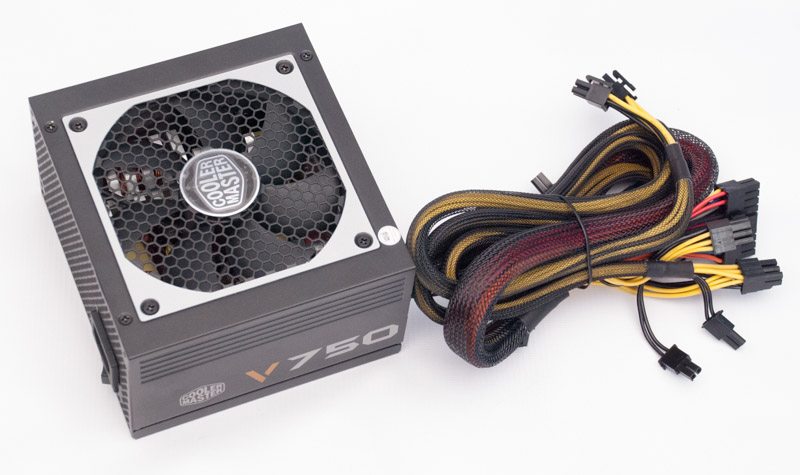
Cooler Master have earned a solid reputation as one of the leading providers of power supplies in the desktop and enthusiast market, and rightly so. Unlike some PSU vendors Cooler Master do not tend to stick with the same OEM and have used CWT, Enhance and Seasonic to ensure they always get the best balance between price and performance depending on the product they are making. Today we are looking at a power supply that is produced for Cooler Master by Enhance, one of Cooler Master’s favoured OEMs of late. We have also seen the Enhance OEM used in many of Cooler Master’s Silent Pro Hybrid series power supplies. On the bench for this review is Cooler Master’s brand new V750 power supply. Boasting 750W of 80 Plus Gold Rated power with a low RPM fan and a semi modular design Cooler Master’s V750 looks like a very nice offering. It also comes in an incredibly compact form factor being just 5.5 inches in length and better still it has a very reasonable MSRP of $110. So without any further ado let’s proceed into this review and see how it performs!
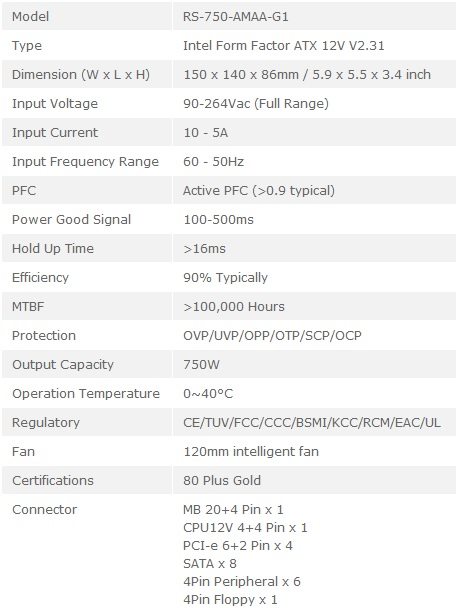
Packaging and Contents
On the front of the packaging Cooler Master proudly display the 80 Plus Gold certification, use of Japanese capacitors and 3D Circuit design.
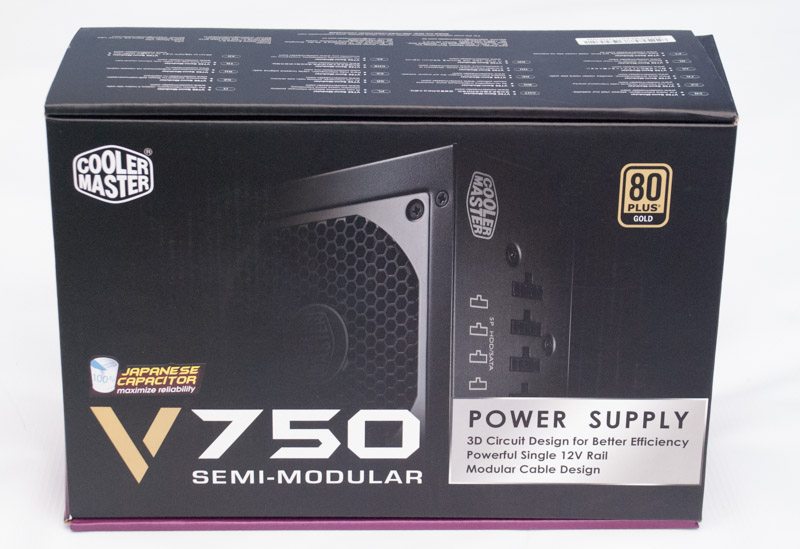
On the back we find details able the cables on offer, the fan curve and the efficiency curve. Cooler Master also mention that the specific Enhance OEM design they are using is exclusive to them.
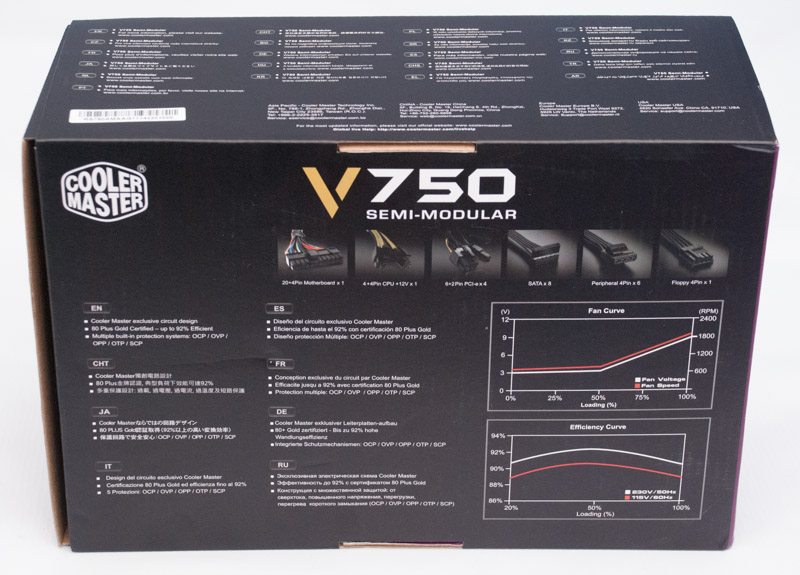
Included with the V750 is simply a power plug, set of black case screws and user’s manual.
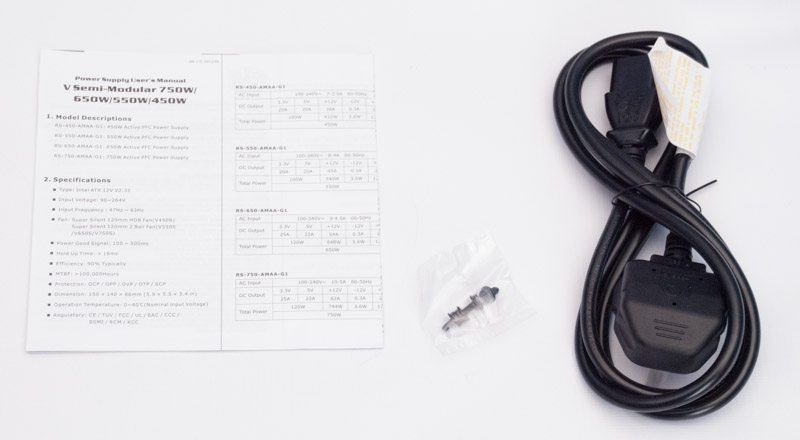
A Closer Look – Exterior
Power Supply Unit
Cooler Master’s PSUs always look very nice thanks to the contrast between the brushed aluminium plate and the textured black finish of the power supply unit.
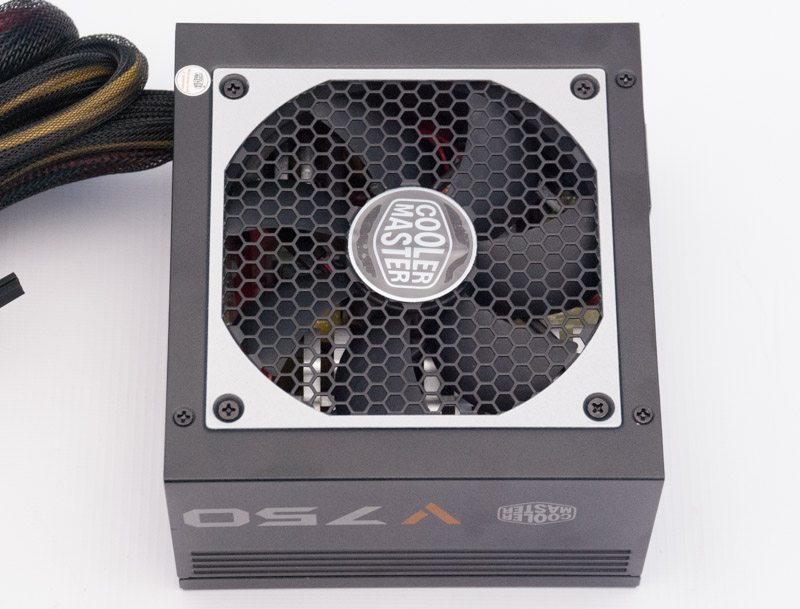
We find identical patterns and logos on both sides of the PSU except they are flipped depending on how you want to mount your PSU.
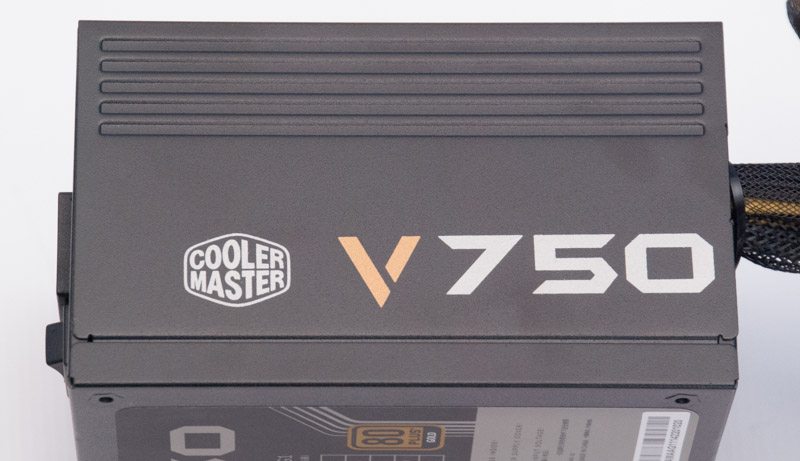
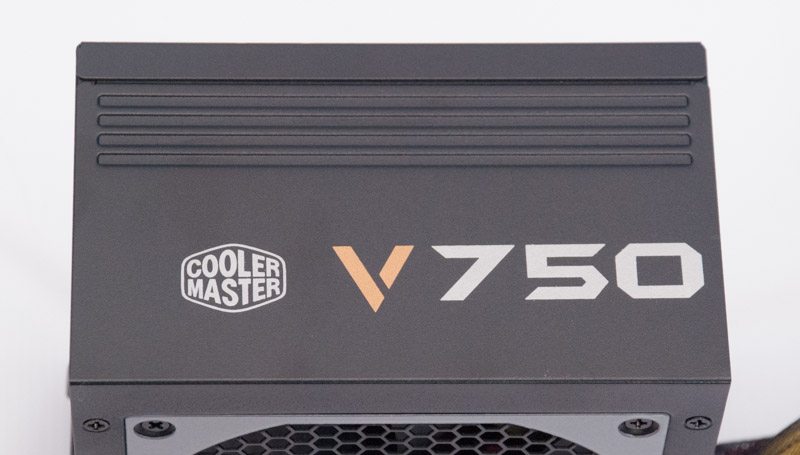
The bottom features the label which details certification, amps, watts and rail specifications.
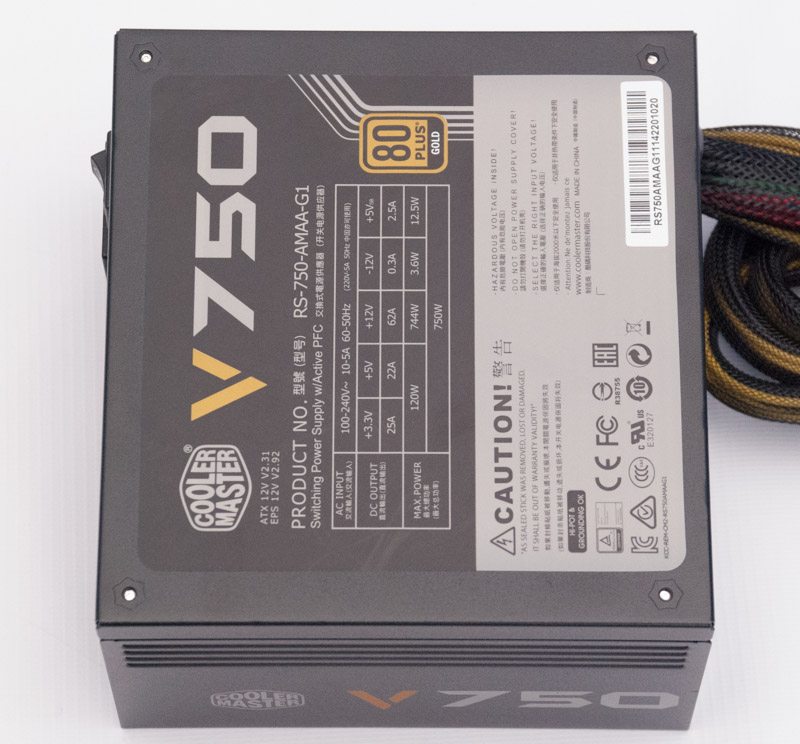
On the cable end we find modular connectors for your SATA, molex and floppy connectors.
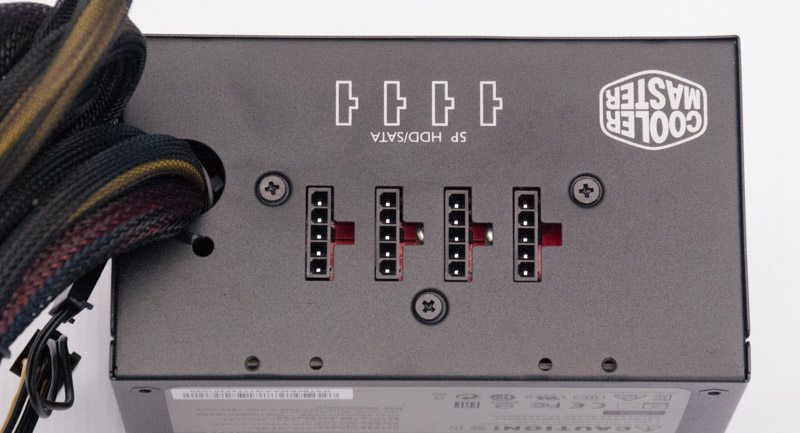
The back is very plain with some hexagonal ventilation, a power input and a power switch.
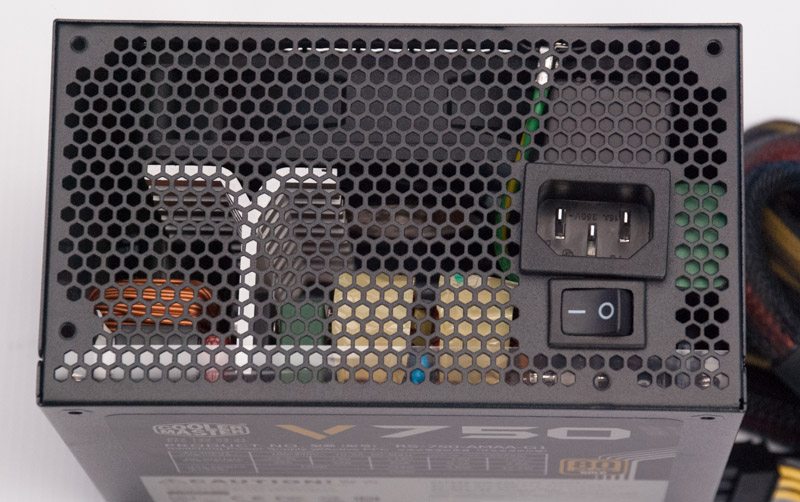
Cabling
Hard wired to the unit is a motherboard 20+4 pin, four 6+2 pin PCIe connectors (which are daisy-chained) and a CPU 4+4 pin.
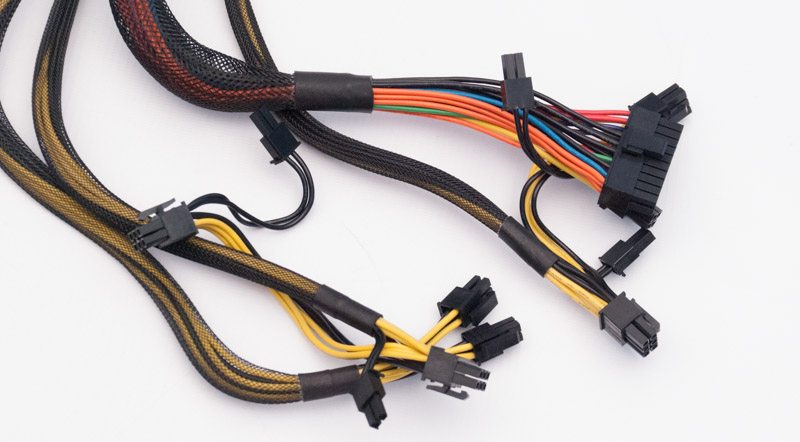
There are 4 modular cables, the first has three molex, the second has another three molex with an FDD connector, the third has four SATA and the final one also has four SATA.
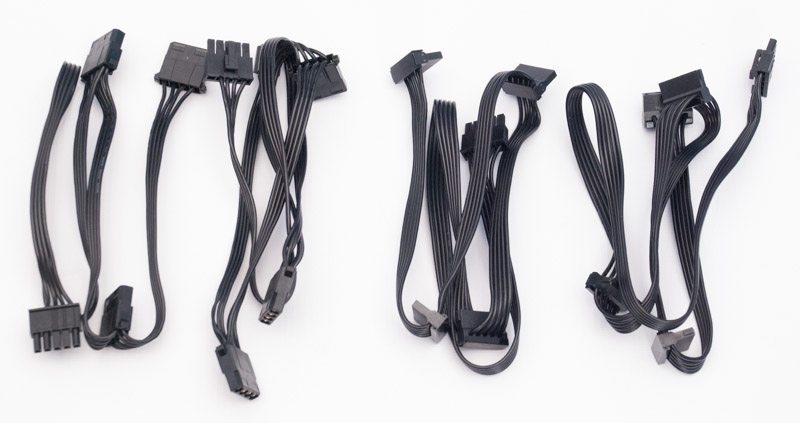
A Closer Look – Interior
As we’ve already mentioned Cooler Master are using the Enhance OEM for this power supply, this design is exclusive to Cooler Master so it won’t be found in any other brand’s products. The design makes use of a 560 uF, 450V and 105 degrees rated Panasonic hold up capacitor as well as an array of 105 degrees rated Nippon Chemi-Con capacitors used for regulation. The Enhance 3D Circuit design makes use of an LLC resonant converter and DC-DC converters for the minor rails. The supplied fan is Yate-Loon made and can operate up to 2300 RPM if needed, given the efficiency of this unit I do not expect it would need to operate that fast.
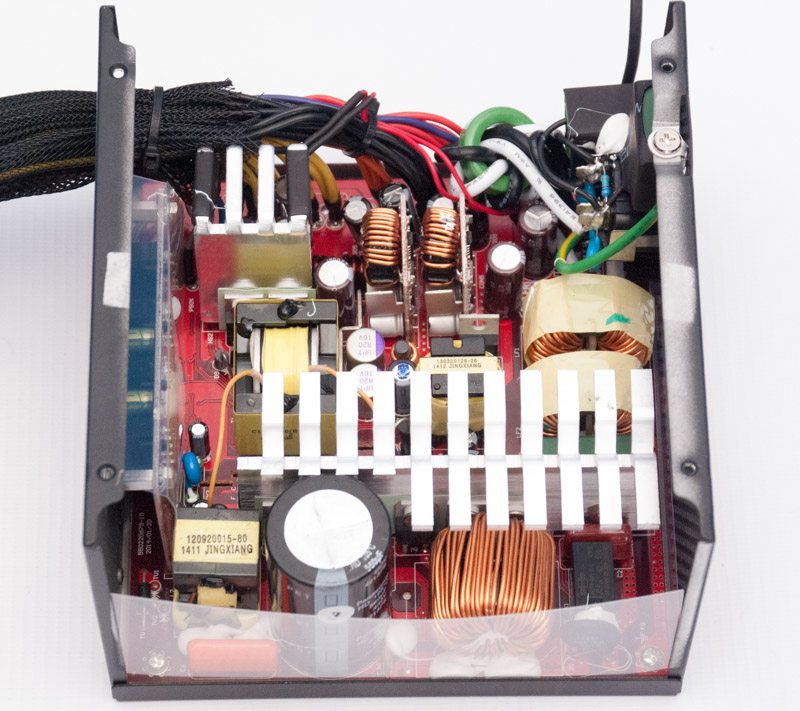
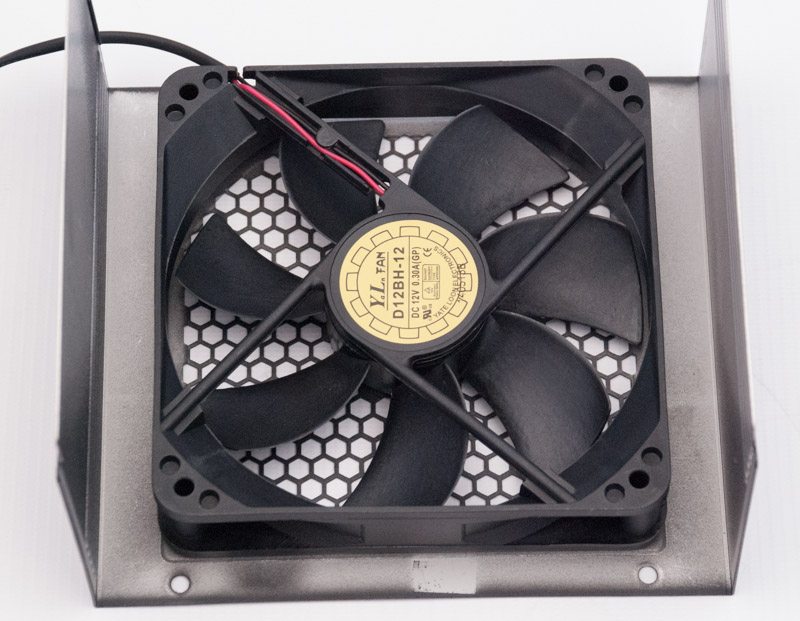
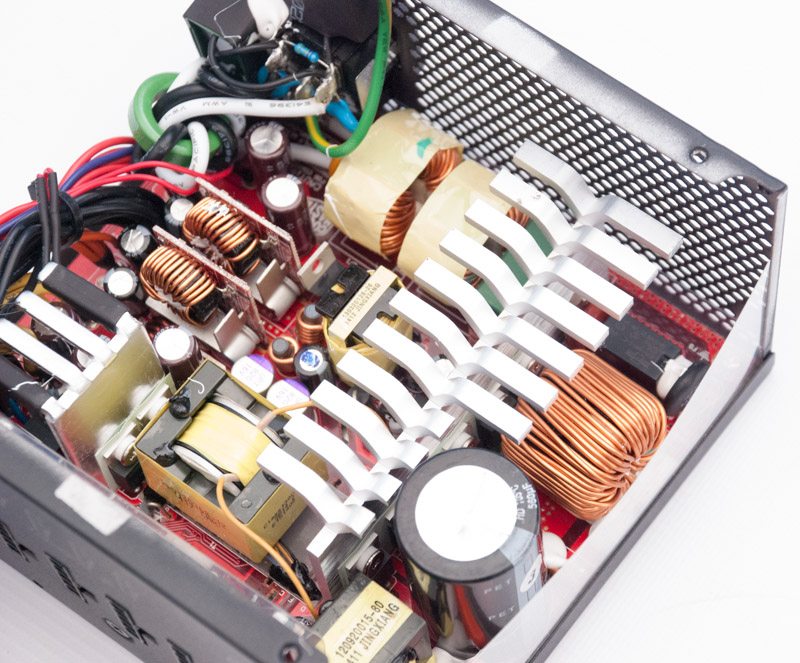
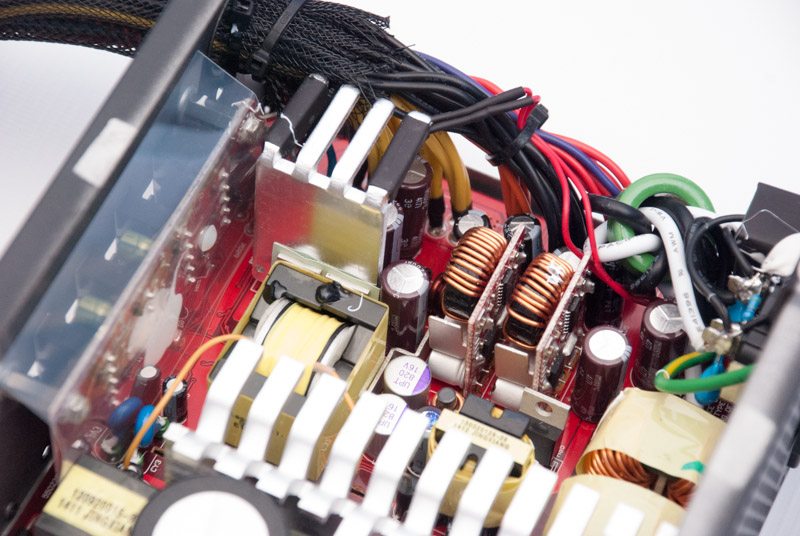
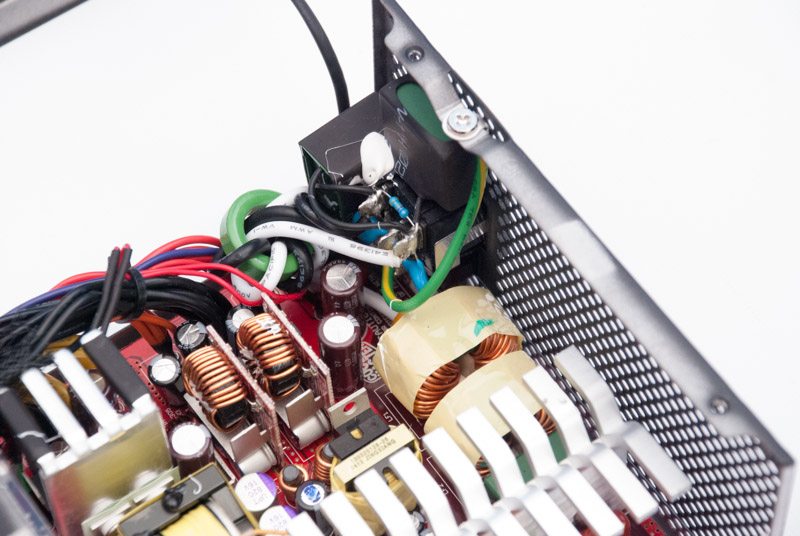
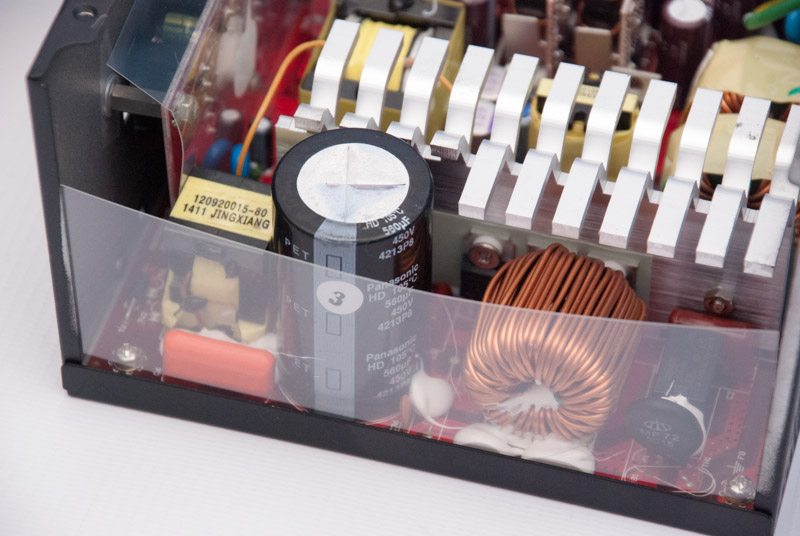
Test Procedure
At eTeknix we take the power supply testing procedure very seriously and have invested a lot of resources into acquiring the appropriate testing equipment. For all power supply reviews we test the power supplies with dedicated power supply testing equipment. This means we are able to get the most accurate results from our testing as opposed to using software benchmarks (such as OCCT) or multi-meter readouts which are broadly inaccurate.
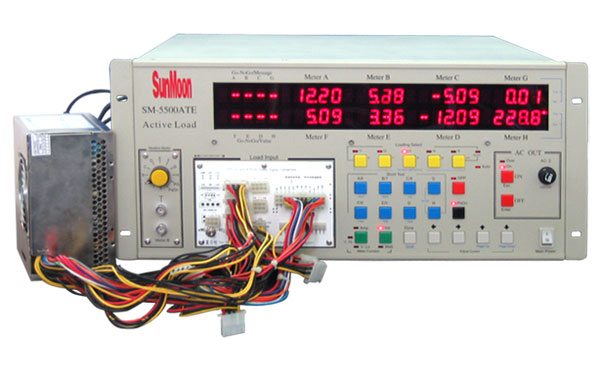
Our test machinery is as follows:
- Sunmoon SM-5500ATE Active Load Tester (1200W rated)
- Sunmoon SM-268 Active Load Tester (450W rated)
- GW Instek GPM-8212 Digital Power Meter
- Stingray DS1M12 USB Oscilloscope
- Voltcraft DT-10L laser tachometer
The eTeknix test procedure involves:
- Testing each power supply at 20/40/60/80/100% load (with balanced load across all rails) and measuring PFC (power factor correction), efficiency (actual power divided by power “pulled at the wall”) and voltage regulation (deviance from expected voltages of 3.3/5/12 on the main rails).
- Measuring ripple with an oscilloscope at 20/40/60/80/100% load.
- Measuring fan speed after a stabilisation period of five minutes at each load scenario using the Voltcraft DT-10L laser tachometer and a reflective strip on the fan.
- Testing each power supply’s OPP (Over Power Protection) mechanism and seeing how many watts each power supply can deliver before shutting down
Other things to consider are that
- We recognise that a single yellow 12 volt cable can provide only 6 Amps before overheating (which corrupts voltage regulation and efficiency) and so we used an adequate number of cables for each power supply to ensure there is not efficiency loss from poor cables selection
- Our Sunmoon SM-5500ATE power supply tester is not capable of testing more than 300W on each of the 12 volt rails so where a power supply provides more than 300W on a 12 volt rail that power is distributed over multiple 12 volt rails on the load tester. For example a power supply with one 12 volt rail supplying 750 watts would be spread equally over three 12 volt rails on the load tester, a power supply with two 450W 12v rails would be spread over four 12v rails on the load tester, two 225W 12v rails for each of the 12v rails on the unit.
- We use the same time scale and horizontal millivolt scale on our oscilloscope for all ripple tests, that is a 20ms T/DIV (horizontal) and a 0.02 V/DIV (vertical) meaning the scale is from -80mV to +80mV, ATX spec dictates that the 12v rail must fall within 150mv of ripple and the 3.3/5 within 50mv so that scale allows us to include both 150 and 50mV peaks. (Some older PSU reviews use different scales which were later ditched as the visual representation they give is inadequate, in these reviews written measurements are provided only).
- Deviance is the terminology used to represent the way voltages diverge from the expected values
Efficiency, PFC and Voltage Regulation
Voltage Regulation
To test voltage regulation we load the power supply to five different load scenarios that give an equal spread of load across every single rail. So that means 20% on all rails, 40% on all rails and so on. We then calculate the average deviance of each rail from its expected voltage.

Power Efficiency
Power efficiency is measured by calculating actual supplied wattage divided by the wattage drawn at the wall/plug, multiplied by 100 to give a percentage. We then compare that to the particular 80 Plus certification the company claims to see if it meets that. You can see the 80 Plus certifications below, we always test 230v power supplies.
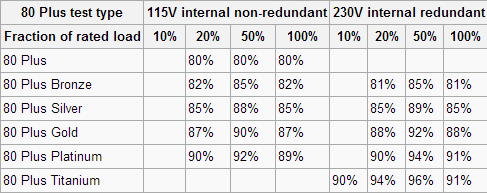
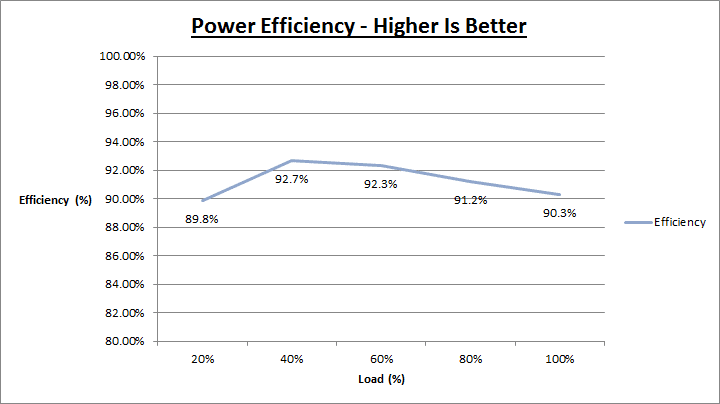
Power Factor Correction
Power Factor Correction is the ratio of the real power flowing to the load, to the apparent power in the circuit. The aim of PFC is to make the load circuitry that is power factor corrected appear purely resistive (apparent power equal to real power). In this case, the voltage and current are in phase and the reactive power consumption is zero. The closer the number to one the better as this allows the most efficient delivery of electrical power (Source – Wikipedia).
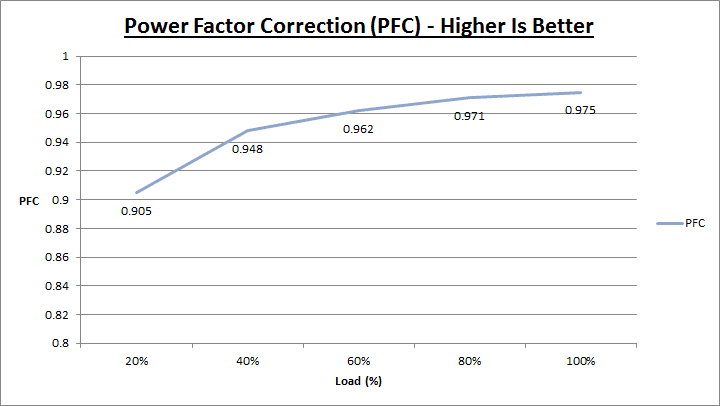
Ripple
Noise and Ripple can easily be measured by an oscilloscope. These show how much voltage fluctuation there is on a particular rail. We tested the rail stability of the 3.3 volt, 5 volt and 12 volt rails using an identical time and millivolt scale for all graphs. millivolt ripple is measured by the peak to peak size of the voltage curve.
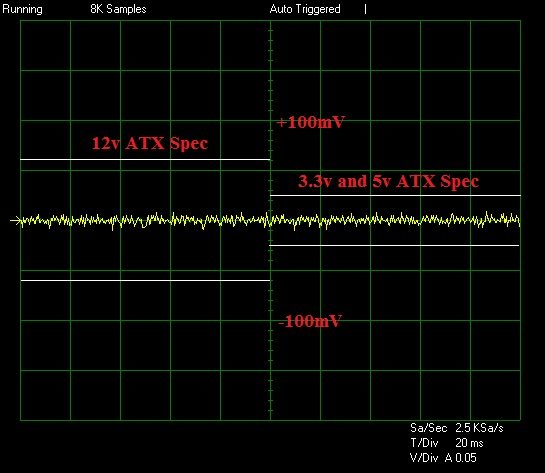
Sample Ripple Graph
The latest ATX 12 volt version 2.3 specifications state that ripple from peak to peak must be no higher than 50 millivolts for the 3.3 volt and 5 volt rails, while the 12 volt rail is allowed up to 120 millivolts peak to peak to stay within specifications. Millivolt figures are stated to the closest increment of 5 given their variability.
| Load (%) | 3.3V Ripple | 5V Ripple | 12V Ripple |
| 20 | 10 | 5 | 10 |
| 40 | 15 | 10 | 20 |
| 60 | 20 | 15 | 25 |
| 80 | 20 | 20 | 25 |
| 100 | 20 | 20 | 30 |
Over Power Protection and Max Wattage
Power supplies often quote as having various protection mechanisms such and the most important of these is Over Power Protection. In our testing we crank up the power draw until the power supply either shuts down (meaning the OPP mechanism is present and working) or blows up (meaning it is either not present or not working). We then note the maximum power consumption before the power supply shut down (or blew up).

Fan Speed
When testing in a power supply laboratory it is difficult to take fan noise readings as the noise from the Sunmoon test equipment and air conditioning corrupts everything. The next best thing in our circumstances was reading off the fan speed with a tachometer to get an idea for the noise. The ambient temperature during testing held constant at 22 degrees, with 1 degree of variation. Each power supply had a consistent time period of 5 minutes to stabilise between each load scenario.
In my experience the following general relationships apply between noise levels and fan speeds, though it can vary greatly between the type of fan used.
- Below 800 RPM – Inaudible/Silent
- 800 to 1000 RPM – Barely audible
- 1000 – 1200 RPM – Audible but still quiet
- 1200 – 1400 RPM – Moderately noisy
- 1400 – 1800 RPM – Noisy
- 1800 RPM or higher – Intolerable
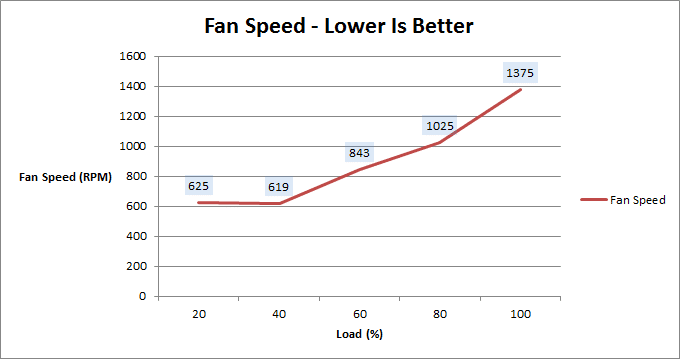
Final Thoughts
Pricing
Cooler Master’s V750 is currently going for $110 on Amazon and $100 on Newegg in North America and in the UK it can be had for £87.28 at Scan Computers. Cooler Master’s V750 is part of Cooler Master’s Gold Guarantee which means they offer a 5 year parts and replacement warranty.
Conclusion
Cooler Master’s V750 has impressed me and I think this power supply is going to be very popular for a number of reasons, but before I get into those let’s discuss its performance. Firstly, it offers very good voltage regulation across all rails, the only minor point to note is the voltage does droop a little below 12v at higher loads but the amount is negligible and nothing to be concerned about. Secondly, the ripple suppression is excellent across all rails, the 3.3, 5 and 12 volt rails all had class-leading performance, only digitally controlled or platinum rated power supplies are able to better it at a much higher cost. Thirdly, the efficiency and PFC performance are very good, easily exceeding what is expected of 80 Plus Gold. Finally, the fan was broadly very quiet and only became noticeable in the 80-100% load region, but even then it would still be fairly quiet inside a case.
Performance aside I think the small size of this unit will definitely appeal to small form factor system builders like those doing mini-ITX and micro-ATX systems inside compact cases. I think the fact the design is semi-modular also helps because everyone who buys this will need motherboard, CPU and PCIe power connectors, Cooler Master haven’t pre-fixed any unnecessary cables which is always good to see. The only down sides for me are that the hard-wired cables aren’t to the usual “enthusiast” standard of being all black and sleeved to a high standard: the sleeving feels a little cheap and the multi-coloured cabling will be a turn off for some enthusiasts. Cooler Master should consider better cables or a fully modular variant to really nail down the enthusiast support for this product, even if it means offering a more expensive SKU.
Pros
- Higher than rated efficiency
- Excellent PFC
- Quiet operation
- Competitive pricing
- 5 year warranty
- Compact design
Cons
- Slight 12v droop at maximum loads
- Hard-wired cables could be improved aesthetically
“Cooler Master’s V750 is a power supply offering that combines silence, high performance, excellent efficiency and a compact size at a very reasonable price point. This power supply will be ideal for high performance small form factor systems.”
Thank you to Cooler Master for providing this review sample.




















